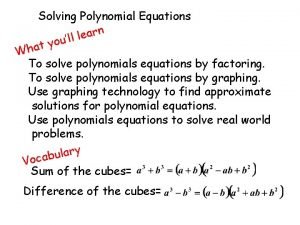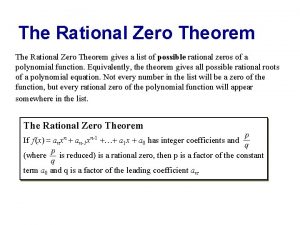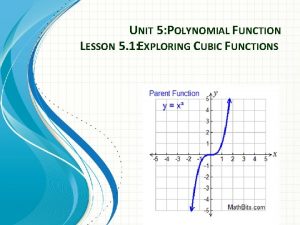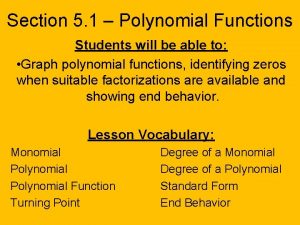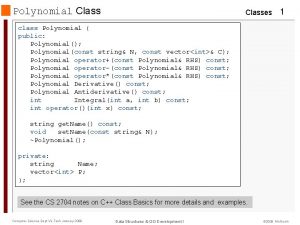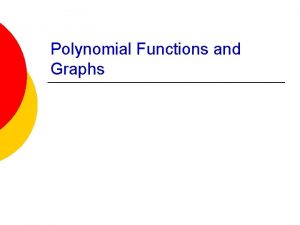Polynomial Functions Polynomial Functions An equation having a













- Slides: 13

Polynomial Functions

Polynomial Functions �An equation having a variable raised to an exponent of a non negative integer �Degree: the highest power on the variable second degree �i. e. f(x) = x 2 + 1 third degree f(x) = x 3 + 1 first degree f(x) = x + 2 zero degree (no variable) f(x) = 3

Zero Degree Polynomials Constant Functions

Constant Functions �A constant function is described by the rule f(x) = b where b can be any number �The rate of change (slope) is zero �Horizontal line with equation y = b (0, 3) y = 3

First Degree Polynomials Linear Functions

Linear Functions �A linear function is described by the rule f(x) = ax + b where a cannot equal 0 �The parameter “b” is the y-intercept �The parameter “a” represents the rate of change (slope) �If a > 0, rate of change is positive �If a < 0, rate of change is negative Rate of Change = y 2 – y 1 x 2 – x 1 Point 1 (x 1, y 1) Point 2 ( x 2, y 2) 2 -2 2

Second Degree Polynomials Quadratic Functions

Quadratic Function Standard Form f(x) = a(x-h)2 + k a>0 General Form Vertex: (h, k) Axis of symmetry: x = h f(x) = ax 2 + bx + c Zeros: h Vertex: Factored Form f(x) = a(x-x 1)(x-x 2) Zeros: x 1 and x 2 Axis of Symmetry: x = a<0 Axis of symmetry: x = Zeros: y intercept: c

Example The following formula links the speed v in km/h and the distance d in metres necessary to bring a car to a complete stop in case of emergency. 100 d = v 2 + 20 v At what speed is a car travelling if it needs 63 m to come to a complete stop? 100(63) = v 2 + 20 v 6300 = v 2 + 20 v - 6300

Example The parabola represented below crosses the x-axis at the points (-1, 0) and (3, 0) and its vertex is the point P(1, ‑ 4). f(x) = a(x-h)2 + k f(x) = a(x-1)2 - 4 0= a(3 -1)2 - 4 0= 4 a - 4 a=1 f(x) = (x-1)2 - 4 f(x) = (x-1) - 4 f(x) = x 2 - x – x +1 - 4 y = x 2 2 x 3 What is the equation of the parabola graphed above in general form?

Example �One leg of a right triangle exceeds the other leg by four inches. The hypotenuse is 20 inches. Find the length of the longer leg of the right triangle. c 2 = a 2 + b 2 20 x x+4 202 = x 2 + (x + 4) 2 400 = x 2 + (x + 4) 400 = x 2 + (x 2 + 8 x + 16) 0 = 2 x 2 + 8 x -384

Example The height, h(t), in feet of an object above the ground is given by h(t) = -16 t 2 + 64 t + 190, where t is the time in seconds. a) Find the time it takes the object to strike the ground b) Find the maximum height of the object. Vertex:

Example A diver jumps off the side of an inground swimming pool and reaches a depth of 2. 6 meters at a distance of 1. 95 m away from the ledge. He enters the water at a distance of 1. 76 meters from the ledge. Determine the maximum height during his trajectory assuming that he followed a parabolic motion. Vertex: f(x) = a(x-x 1)(x-x 2) f(x) = a(x-0)(x-1. 76) -2. 6 = a(1. 95 -0)(1. 95 -1. 76) -2. 6 = a(1. 95)(0. 19) -2. 6 = 0. 3705 a a = -7. 02 (1. 76, 0) f(x) = -7. 02 x(x-1. 76) f(x) = -7. 02 x 2 + 12. 36 x (1. 95, -2. 6)
 Matplotlib inline
Matplotlib inline How to divide a polynomial by another polynomial
How to divide a polynomial by another polynomial Nature of the roots
Nature of the roots How to solve polynomial equations
How to solve polynomial equations Polynomial word problems
Polynomial word problems Third degree polynomial equation
Third degree polynomial equation How are polynomials used in real life
How are polynomials used in real life Polynomial roller coaster project
Polynomial roller coaster project Polynomial equations
Polynomial equations 6-5 finding real roots of polynomial equations
6-5 finding real roots of polynomial equations Rational zeros theorem
Rational zeros theorem Unit 5: polynomial functions
Unit 5: polynomial functions Structure in graphs of polynomial functions
Structure in graphs of polynomial functions 5-1 polynomial functions
5-1 polynomial functions








